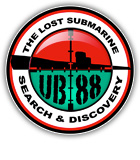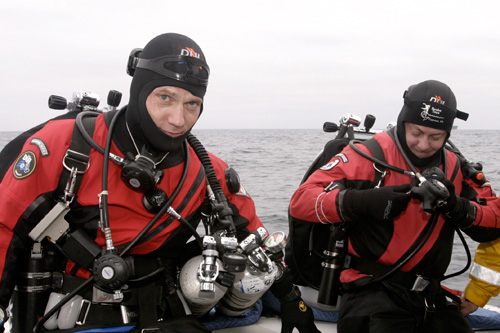
Tech divers Kendall Raine (left) and John Walker prepare to make their first decent to the wreck site of UB 88 on August 27, 2003. Photo by Gary Fabian.
UB 88
Dive Report
By
Kendall Raine
August
27, 2003
I was born July 9, 1959. On July 9, 2003 I received an
e-mail from Captain Ray Arntz. It read “Hey Kendall,
Give me a call. I think I’ve got a project.”
A project with Captain Ray? That could only mean one thing.
A new wreck. Deep too, if he was contacting me. Happy
Birthday to me.
When I spoke with Ray the news was better than I could have
hoped. Not only did Ray think he and his partner Gary had
found a new wreck, but the wreck of the only German U-boat
in California waters, the famed UB 88. They even had drop
camera and digital sonar images of the wreck. No more rock
pile dives.
“The wreck’s deep. We need some video to nail
it as the UB 88. Can you do it?” Ray asked.
“No problem. Top secret right?” I responded.
“Top secret. My partner Gary and I have worked too
long and hard to have this get out. No screw ups and no
show boating. Gary and I have complete control on
disclosure. We need this done right the first time and kept
quiet. Understood?” Ray answered.
Understood? Gee, let me think about that. “Of course,
it’s your show.” I responded.
“Who do you want with you?” Ray asked.
No screw ups and no show time. Hmm. That’s easy.
“Johnny and I can do it alone” I said.
“Mid-week and not your boat. It’s too well
known.” I continued.
“Johnny Walker? Perfect. We’ll probably use my
partner Gary Fabian’s boat. He actually found the
wreck and the one who’s done most of the work on this
thing. If you think I’m good at finding stuff, you
should see this guy. He’s better than I am. I’m
busy with mid-week charters until mid-August. What
works?” Ray said.
“We’re cave diving in Mexico until August 23.
How about August 27, Wednesday?”
“Done.” Ray hung up.
Wow. Just like that. Ray and I had been discussing the UB
88 for years. I’d even visited a few deep rock piles
in search of it and suddenly this invitation. Despite
rumors of it having been found, despite rumors for years of
people having the numbers of the UB 88, I’d never
seen any proof of either. From what I knew, we’d be
the first to dive this wreck.
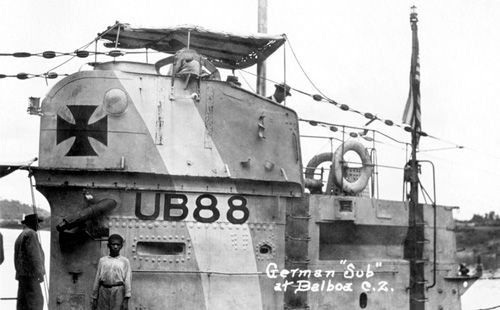
UB 88 at Balboa Canal Zone, 1919
The UB 88 was a Type UB III German submarine built in
Hamburg, Germany and commissioned in January 1918. Despite
her late entry to the war, UB 88 managed to sink 13 ships
and damage two more during ten months of service. Sent to
the United States after the end of the war, UB 88 was
paraded around the eastern seaboard as part of the Victory
Bond drive before departing for California via the Panama
Canal. Based in San Pedro, UB 88 also cruised the West
Coast raising money until 1921, when she was stripped and
sunk in a live fire exercise by “Bull” Halsey
during his first command aboard USS Wickes (DD-75) (sister
ship to the Hogan and Radford). She is the only known
U-boat from either war in California waters. She was one of
six WWI U-boats given to the US by Great Britain at the end
of WWI. One of her sisters was apparently recently found in
Lake Michigan.
I left my house at 5 am August 27 bound for John
Walker’s house. In the car was loaded my double
104’s with 15/50 and the deco gas necessary for a 25
minute dive at the target depth. There was no traffic and I
made John’s house at 6:15. We loaded up and drove to
Ray’s and from there down to Long Beach to meet up
with Gary and the rest of the team.
Gary’s boat was moored in Long Beach and it was there
that we met other members of the project, Mike Lapinski and
Harry Davis. Mike would assist Ray in the hooking and
gearing up process, while Harry would shoot topside video
while Gary handled the boat and shot top side stills. We
loaded quickly and headed out to sea. Running at 15 knots,
the trip would take us under an hour on our southeasterly
heading to the wreck site. Gary recalled his two-year
search for the wreck and his search process. Ingenious
would barely describe it. It was clear this project had
consumed Gary as much if not more than Ray and their pride,
enthusiasm and anticipation was infectious. En route, we
reviewed drop camera footage taken in July. I could see why
Gary and Ray thought they had something. Whatever it was,
it wasn’t a rock pile or culvert. Sonar measured the
target about 175 feet in length. The UB 88 was 182 feet
long and a 19 foot beam. The sonar readings suggested she
was largely intact. The drop camera confirmed this was a
ship wreck and the few clear frames bore resemblance to
deck plans of a Type UB III World War I German submarine.
Gary found the wreck on the first pass and Ray dropped a 50
lbs ingot tied to a float over the side. The plan called
for us to establish an up line and then live boat. We
reviewed procedures and then dropped over the side up
current of the float. Our biggest concern was crew boat
traffic as we weren’t far from platform Elly-Ellen.
Our dive plan was to tie the up line into the wreck and
swim both sides trying to capture signifying marks along
the way. If the conning tower was intact-action reports
suggested it might have been destroyed during the live fire
exercise-we would video that. I would lead, run lines and
spot video targets. John, with his new Halcyon lights fresh
from the caves of Mexico, would video the dive.

Descending to the Wreck Site
The water at the surface was pea green so John and I stayed
close on the descent. The water started to clear below 50
feet though we never got viz better than about 25 feet.
Approaching target depth, I searched in the gloom for any
sign of the wreck. As the sand came up, I broke out a
spool, tied into the up line and headed in the direction of
what looked like the shadow of a wreck. Ambient light was
very low at this depth. I was really hoping to avoid a
protracted search since that would kill our gas and
increase our bubble count.
After a thirty foot swim the wreck appeared. Curved and
covered with corynactus, our initial impression was of a
cylindrical hull broken in parts exposing an inner hull. I
tied in the spool and turned left leading the dive.
Johnny’s twin 24 watt HID’s created an enormous
glow behind me and I knew he was busy doing his job. We
swam over a large flat plane extending out of the side of
the hull. A close look revealed a plane inside another
plane with the inner plane connected to the hull at the
center. The inner plane was clearly designed to pivot. It
was obviously a diving plane with a guard around it. Now I
was getting really excited. Not too many surface ships had
diving planes.
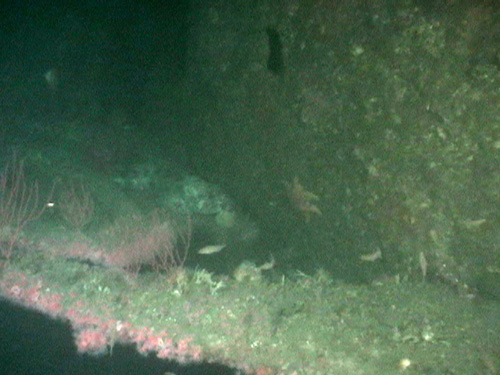
Port Dive Plane
A short swim further on and we came to a wrecked area and
the end of the hull. I thought “We’re probably
at the bow.” Swimming around the wreckage, I came to
the other side of the hull. At this end the beam was
probably no more than ten feet. Twenty feet aft of the
wreckage another large plane rested on the sand-the other
dive plane. Right where it was supposed to be. A large hole
in the outer hull was smooth and obviously pre-existing-the
anchor housing! Oh this was getting to be fun!
Swimming back along the hull, I kept looking up to see if
the conning tower was there. In another minute, there it
was. Rising 15 feet above the top of the hull, it was
covered with a carpet of corynactus and loomed imposing
against the green backlight. “Well, that just about
nails it!” I said into my regulator in my Donald Duck
helium voice. I hope Johnny gets this shot.
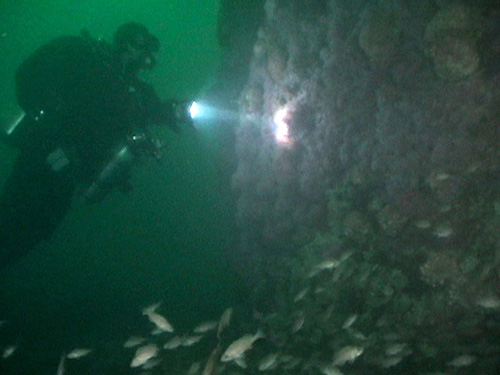
Conning Tower
One more thing to do, though. I ascended the side of the
conning tower. A reverse block developed which gave me a
brief case of the spins. Holding onto the conning tower to
let it subside, I floated up to the top to witness what
I’d come for. Two holes about four inches in diameter
and three feet apart were at the top. Periscope wells.
Bingo! There was absolutely no doubt that this was a sub.
Suddenly the gloom was illuminated by car headlights.
Heeeeere’s Johnny. I moved out of the shot and
pointed with my light at the periscope wells. In front of
these appeared what looked like a hatch handwheel.
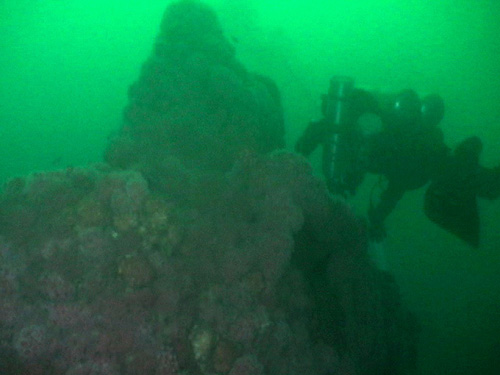
Periscope Wells
I then swam back down to the hull and headed aft. Behind
the conning tower were two hatches, their hand wheels
heavily encrusted but still clearly visible. A groove in
the pressure hull formed at the junction of the ballast
tanks and the pressure hull, and evident in war time
photo’s of subs under construction, was clearly
obvious. A hole directly into the pressure hull appeared
allowing me to shine my light into the interior of the sub.
Cool.
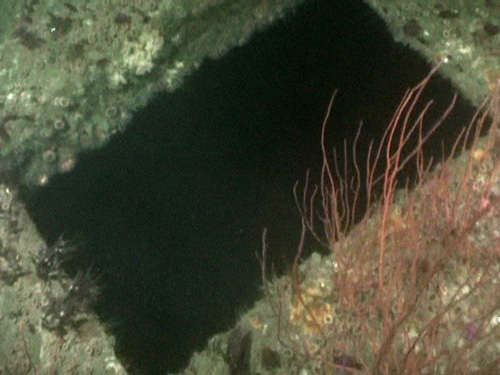
Access to the Interior of The Submarine
Swimming further back I came upon a large net suspended off
the hull by floats. The net was obviously very old.
Dropping behind the net I came to the stern. A steel rail
originally attached to the stern lay in the sand. Another
obvious clue that this was the UB 88 - the rail appears in
the deck plans and is unique to Type UB III boats.
Swimming around to the port side of the wreck, I was able
to make out propeller shaft struts and the flange into the
hull. The shafts and propellers had been removed in San
Pedro Navy Yard prior to sinking. Johnny was again right
behind me getting everything. “Ray’s going to
be a happy man with this video” I thought.
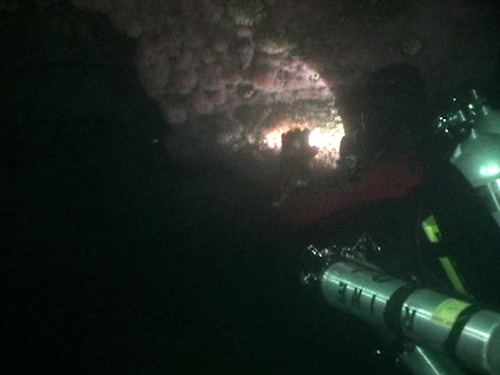
Propeller Shaft Strut
I continued forward and examined various places where the
outer hull had been breached exposing the pressure hull.
Finally, I again came upon the bow plane I had seen at the
beginning of the dive. This time I noticed a torpedo tube
protruding from the pressure hull. I ran my light back and
forth along the length of the torpedo tube-a sign for John
to film it. True to form, Johnny was right there and nailed
it.
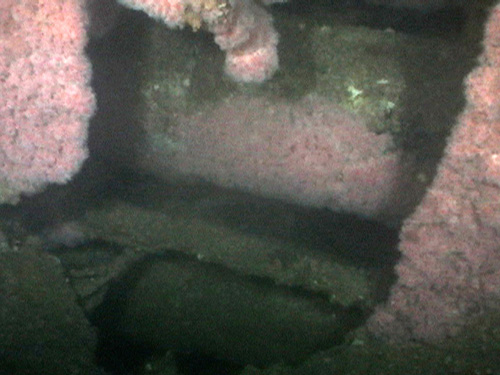
Torpedo Tubes
Time was up. I thumbed the dive and pulled my spool. The
line caught on my p valve and caused me to wrangle it a bit
much to Johnny’s delight. I could hear him laughing
into his regulator as I got the line under control and
wound up.
After an hour of deco John and I surfaced and Gary &
Co. picked us up. We drifted in the current as John put the
video on the TV. The video was spectacular. Any doubts were
erased. Not only was it undeniably a submarine, multiple
identifiers made identification as a Type UB III boat
virtually beyond question. Much merriment ensued.
The ride in was spent discussing various aspects of what
we’d seen and Gary and Ray’s plans to document
their find. Additional dives are being planned to further
document the wreck, though Gary and Ray say they have no
intention of disclosing the location. Because of the
possibility of unexploded satchel charges inside the wreck,
there are no plans to open her up, either. Depth and
entanglement hazards make this wreck hazardous. Unexploded
ordnance on board makes venturing inside very dangerous.
Preparations for sinking took four months and it is
unlikely that many interesting artifacts remain.
Nevertheless, I told Ray I felt honored to be chosen for
this project. The wreck itself is a priceless memory. As
with the Brother Jonathan expedition, being the first to
touch a ship wreck is a very special feeling.
*Underwater video still frames by John Walker
